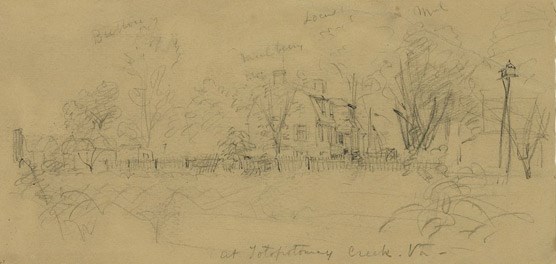|
When the armies left the North Anna River battlefield on May 26-27, each conducted rapid marches to reach new positions. Robert E. Lee’s Confederate army, with the advantage of interior lines, moved straight south through Ashland to a point a dozen miles north of Richmond, where it awaited developments. The Union army took a more difficult, roundabout path, using the Pamunkey River as a buffer. Ulysses Grant’s command crossed the Pamunkey at two locations and pushed southwestward toward Richmond. After an inconclusive cavalry clash at Haw’s Shop on May 28, the head of Grant’s army reached Totopotomoy Creek on the 29th. The wide and shallow creek represented a substantial barrier astride the route to Richmond. Not only did the Totopotomoy’s steeply-shouldered valley stand as a natural obstacle to advancing soldiers, but Confederate infantry and artillery, dug in on the southern side of the creek, further strengthened the position. While the Union Sixth Corps looked for a way around the creek to the northwest, the Fifth Corps advanced at the opposite end of the line and attempted to turn the southeastern end of Lee’s position. Meanwhile the Second Corps anchored the middle, where nature had made the creek valley strongest. The Confederate leaders juggled their forces to counter the various threats, with the Third Corps on Lee’s left, the First Corps in the center, and the Second Corps on the right. A small division of reenforcements under John C. Breckinridge, recently arrived by railroad from the Shenandoah Valley, offered a welcome addition to the army’s ranks. 
Library of Congress Two structures along the creek corridor helped to define the subsequent fighting. One of them, Polegreen Presbyterian Church, stood on high ground just south of the Totopotomoy. The small chapel enjoyed a rich history dating back into the 1700’s, when prominent preacher Samuel Davies called it his home church. Part of Winfield Hancock’s Union Second Corps established a foothold on the southern bank of the creek, near the church, and during the back-and-forth fighting the historic building burned to the ground. A mile to the northwest, the home of the Shelton family (“Rural Plains”) also stood in the line of fire. Built in about 1725, the old home had connections to Virginia patriot Patrick Henry. 110 years earlier he had wed one of the Shelton girls, perhaps at “Rural Plains.” All too often war does not respect cultural landmarks, and such was the case in May 1864. Union signalmen climbed onto the roof of the Shelton House. They watched the effect of outgoing artillery shells and observed Confederate movements on the opposite side of the Totopotomoy. Southern cannoneers in turn bombarded the house, striking it 51 times on May 30 in an effort to drive off the signalmen and disrupt Union arrangements. Unlike Polegreen Church, the Shelton House did not burn to the ground. But the damage incurred in 1864 still scars the house today. Aggressive Confederate infantry under Jubal Early reached a position below the Union lines on May 30, near Bethesda Church. In a series of bold strikes, Early smashed the far left of Grant’s army. Turning north, Early threatened to roll up the Union flank. Strong resistance by the Pennsylvania Reserves along the Shady Grove Church Road spoiled Early’s plans. At the same time, some parts of the Union Second Corps attacked from the Shelton House toward Totopotomoy Creek. A small force even got across the creek and into the Confederate rifle pits, but retreated after dark. The following day (May 31) another spirited attack by the Second Corps again crossed Totopotomoy Creek, only to find that the primary line of Confederate defense stood well back from the actual creek valley. General Grant began to realize that geography and strong Confederate resistance combined to dim his prospects for a sweeping victory at Totopotomoy Creek. He began shifting his army southward toward Cold Harbor on the night of May 31. The fighting at Totopotomoy Creek never took shape as a distinct battle. Instead it was a series of small collisions, erupting at localized points along the line. Reliable casualty figures for the armies between May 29 and May 31 do not exist, in part because the fighting seemed to have no specific beginning or end. Today Richmond National Battlefield Park owns and maintains 124 acres at the Shelton House and down to the banks of Totopotomoy Creek. This includes much of the ground over which Hancock’s men attacked on May 30 and May 31. The ground only came to the park in 2006, and the site is under rehabilitation and development prior to being regularly accessible for visitors to the park. |
Last updated: February 1, 2018
